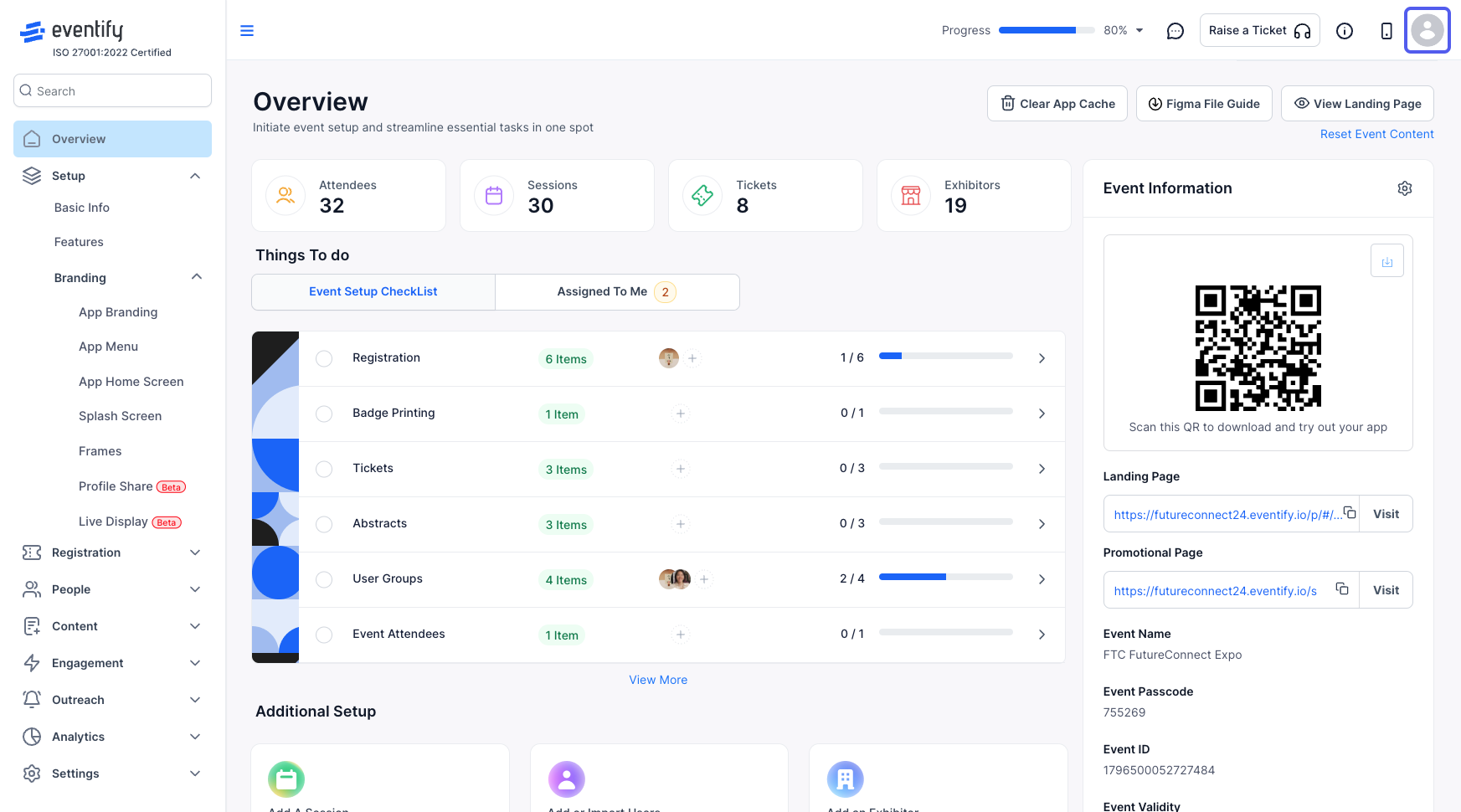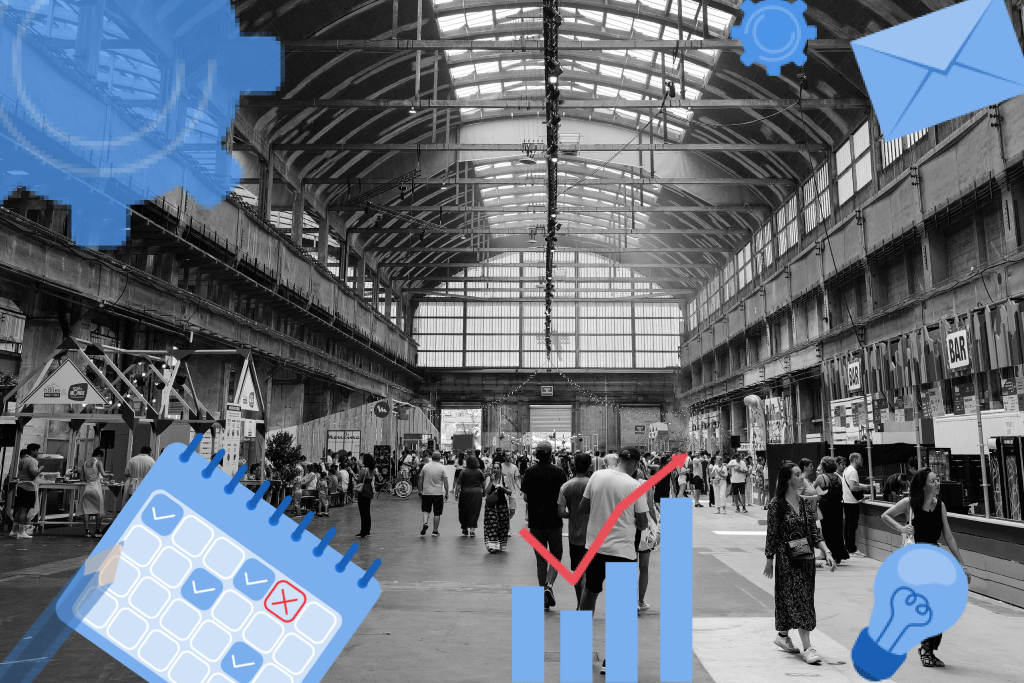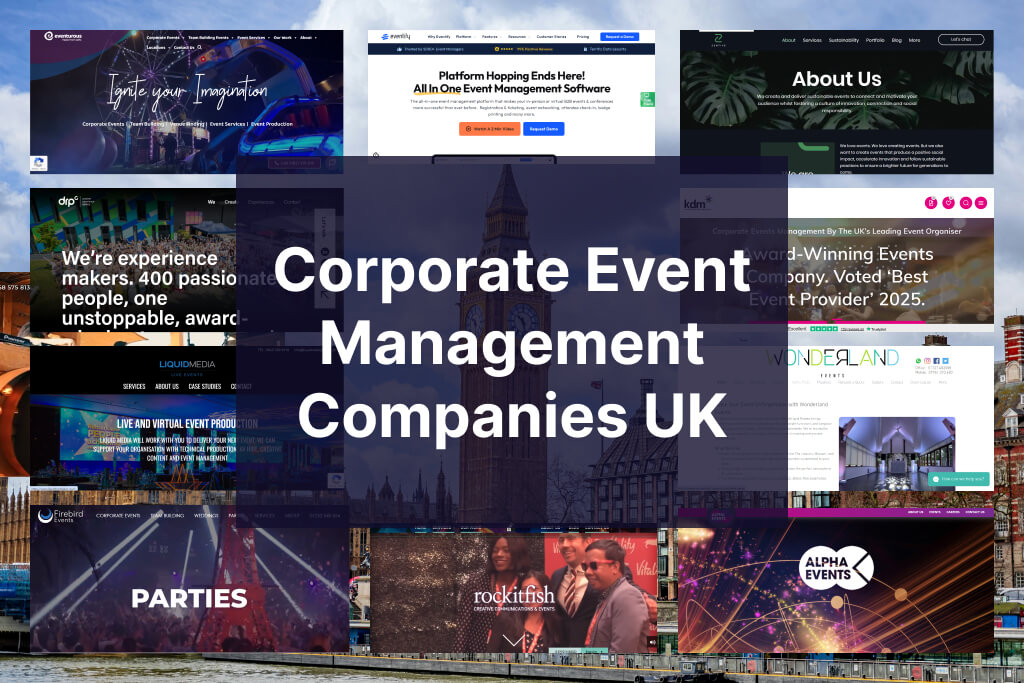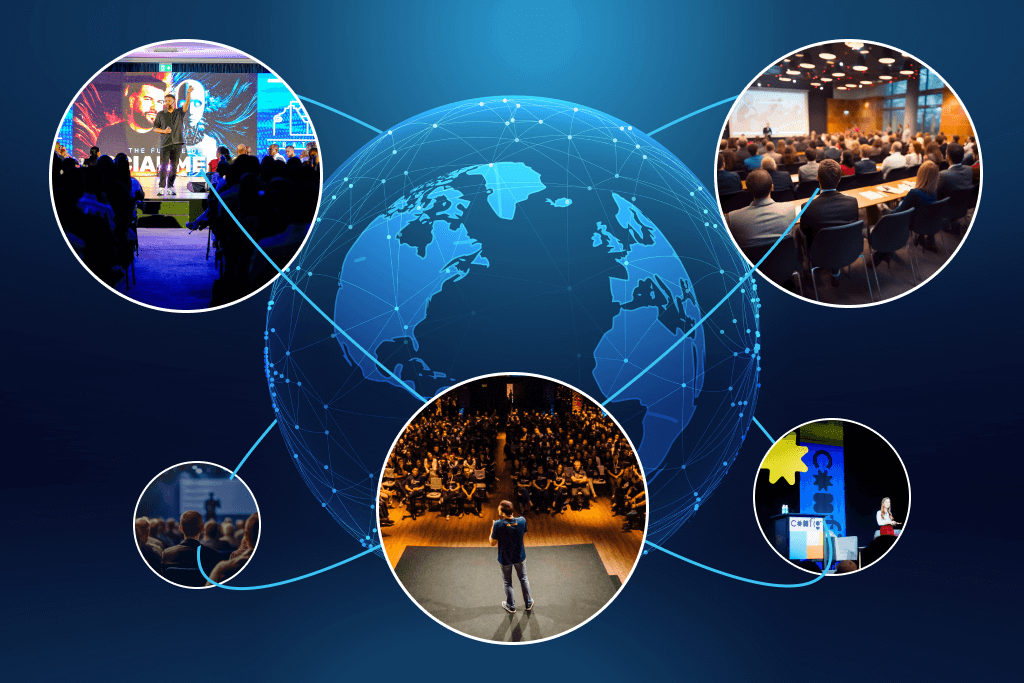As the events industry continues to evolve, hybrid trade shows have emerged as the next step for B2B and B2B exhibitions. 80% of event managers believe that hybrid events have greater reach and engagement compared to other event types, and 61% of organisers find hybrid events more cost-effective than in-person gatherings. According to Market Research, the virtual event marketing industry is projected to grow from $226.75 billion in 2025 to $ 744.41 billion by 2034, at a compound annual growth rate (CAGR) of 14.12% from 2025 to 2034. So far, all data shows that hybrid trade shows aren’t stopping anytime soon. They combine the best of both worlds - the electric energy of in-person audiences and the wider reach of virtual engagement.
In an evolving economy where buyers are everywhere and can be reached through multiple channels, hybrid trade shows ensure businesses meet their buyers where they are, irrespective of geographical or time barriers. In this article, we will explore the benefits and challenges of hybrid trade shows, what you need to put in place for a successful event, and how to maximise the leads from your show.
Different Formats of Hybrid Trade Shows
Depending on your audience's needs and trade show goals, there are different formats of hybrid trade shows you can organise. Remember, the goal is to satisfy your audience with your organisation’s budget and capabilities. Below are the three formats;
1. Simultaneous Hybrid Trade Show
If you want to engage your audience at once, you can simultaneously host the in-person and virtual experiences. The onsite audience is at the event location while the sessions are livestreamed. It can be quite challenging to engage two different audiences at the same time, but it’s not impossible, especially with the right staff and tools. This format also allows for a wider reach and cross-audience interaction and engagement.
2. On-Demand Hybrid Trade Show
If you want to integrate your hybrid trade show into a long-term marketing plan, you can host an in-person trade show and record all the sessions. Then, make the content available on demand to virtual audiences who weren’t at the physical event and in-person audiences who want a replay of the event.
3. Separate Hybrid Trade Show
If you want to minimise stress and risk, you can host both components of the trade show separately. Consider it as duplicating events, with one being in-person, while the other is virtual. This way, you have a wider reach without the stress of juggling two different audiences.
.jpg)
Step-by-step Guide for Planning Hybrid Trade Shows: Before, During & After Event
Unlike traditional in-person events, hybrid trade shows combine both virtual and in-person experiences, and your planning must cover engaging both audiences. Below is a step-by-step guide to follow before, during, and after the event.
Pre-Event
Define your goals
Be clear on what success looks like for you. What do you hope to achieve overall by the end of the event? What are your objectives, e.g., increased leads, improved brand awareness, more sponsor visibility, long-term client relationships, solid thought leadership, etc? Knowing what you want helps you design tailored experiences for both audiences.
Choose the right venue & platform
Ensure the venue for the on-site event is secure and accessible for attendees. If you are hosting attendees with disabilities, ensure there are no mobility issues with the venue. Also, choose the right event tech platform that supports your virtual needs, from livestreaming to detailed data analytics. You can check out Eventify, an all-in-one event application that provides all you need. However, don’t stop at securing the right event platform. Test all the tech tools you’ll be using before the event. If necessary, arrange back-up solutions.

Secure sponsors & exhibitors
Go all out in reaching out to brands whose messages align with yours. Ensure you make your proposals win-win, so they are more inclined to sponsor your trade shows. Also, get your exhibitors ready. Look for those with much-needed, eco-conscious products that satisfy your audience's needs. You should have known who your audience is and what they want before even thinking of a trade show.
Engage multichannel marketing
Go all out in marketing your trade shows. Market across multiple channels - social media, emails, influencer marketing, etc., as much as your budget allows. Tailor your promotion messages to attract your potential audience; be bold in your messaging. Also, use uniform hashtags for easy discoverability on the Internet.
During Event
Seamless delivery
Ensure everything goes seamlessly during the event. Get the right support staff to monitor things. Livestreams should have high-quality audio and video, with closed captions and translation tools for multilingual viewers and those with disabilities. Arrange easy check-ins for both audiences.
Real-time engagement
If you are hosting both audiences simultaneously, ensure you engage both while the sessions are ongoing. It can be challenging to keep track of the virtual audience with an immersive, in-person event, but remember that virtual audiences must feel like they belong too. Use tools like live chats and Q&A to get real-time feedback from your virtual audience. You can assign staff to attend to virtual queries and monitor their engagement.
.png)
Networking opportunities
A highlight of trade shows is networking among attendees. Ensure the atmosphere is right for networking and connections at both components; you can have networking lounges at the in-person event and digital breakout rooms at the virtual experience.
.png)
After Event
Gather feedback
Ask your attendees to provide feedback through post-event surveys. You can also track attendee behaviour and engagement, and check event platform analytics to get data on the overall event. This data can help inform your next line of action for subsequent trade shows or your business, and measure ROI clearly, which you can present to sponsors.
.png)
Nurture your leads
Statistics show that 80% of sales require five or more follow-up calls. Follow up on every lead you get from your trade show with tailored emails, invitations to more events they are interested in, exclusive offers, etc. Build a community out of your target audience to serve as a launchpad for future trade shows.
Debrief with your team
Meet with your team to discuss the highs and lows for the event and identify improvement opportunities for future events. Also, appreciate your team members for working with you; emotional intelligence can make all the difference. Encourage each member to give their honest feedback. Never shy away from difficult conversations; they can be just what you need for your next level.
Benefits of Hybrid Trade Shows for Attendees, Exhibitors, Organisers, and Sponsors
Hybrid trade shows don’t just benefit the organisers; they are a win-win for every stakeholder in the events ecosystem.
Benefits for Attendees
Flexibility and Inclusivity
Attendees can choose how to join, whether virtually or physically, which means no one is left behind. Also, for attendees with disabilities, hybrid formats provide on-demand content with closed captions and screen-reader-friendly tools. For multilingual audiences, hybrid events can provide translation tools so they don’t miss out on any moment during the event due to language barriers.
Smarter networking
Through AI personalisation for hybrid events, attendees enjoy better networking. They save attendees the stress of looking for people to connect with when AI can just match them with like-minded professionals.
Sustainability practices
Due to the growing demand for sustainable practices, many attendees are becoming more eco-conscious. 77% of event attendees expressed a willingness to pay more for sustainable event options. As such, attendees see hybrid trade shows as a means of reducing carbon emissions, which makes them feel more responsible towards protecting the environment.
Benefits for Exhibitors
Cost-effective marketing
Exhibitors don’t have to be restricted by time or budget to reach global audiences. With hybrid models, they can showcase their products to the world without breaking the bank. For instance, for those unable to attend the in-person event due to time, budget, or location, virtual booths for trade shows provide immersive experiences. At the same time, physical exhibitors don’t have to rely on physical audiences alone. They can capture leads from virtual audiences.
Networking & Interactive features
Exhibitors can network with other exhibitors, sponsors, and other stakeholders at the event, which can lead to more business deals. Interactive features such as polls, live Q&A, and integrating games inside virtual booths for trade shows, etc., enable exhibitors to engage the virtual audience in real time, and also gather feedback on the reception of their products.
Benefits for Organisers
Wider reach
With hybrid events, organisers aren’t constrained by budget, time, or venue. For instance, a traditional in-person event that would naturally attract 2,000 attendees can attract two to three times as many with hybrid models. This gives the event more value and credibility, which is effective for getting sponsorship deals, and also provides organisers with increased revenues from both components of the trade shows.
Enhanced data collection
Data is the oil that keeps the machine of the events industry going. Data provides direction, which marketers value the most. Hybrid models allow marketers to capture even the smallest things about audience behaviour, providing deeper insights into what audiences want. Additionally, this leads to better ROI measurement, and they can demonstrate clear outcomes to sponsors and partners, for more sponsorship deals. Platforms like Eventify make data collection easy by centralising attendee data and lead segmentation all in one place, making it easier for organisers to make the right decision.
Benefits for Sponsors
Wider visibility
In a traditional in-person event, sponsor visibility is restricted to on-site brochures and banners. However, with hybrid models, sponsors get wider visibility through livestream mentions, digital ad placements, virtual booths, event software apps, etc. Virtual data capture, such as emails and live chats, can provide segmented and qualified leads for sponsors to follow up on for business opportunities. To make this process easier, you can use Eventify trade show management software for the virtual booths, livestream mentions, and data analytics for your sponsors.
Growth opportunities
Like organisers, sponsors are looking to break into new markets, and hybrid trade shows are an effective way to gather the data to drive that. Sponsors can spot long-term collaborations and potential growth opportunities in different locations from the detailed data analytics from hybrid models.
Challenges and Solutions for Hybrid Trade Shows
Hybrid trade shows can be a lot of fun to organise, but they also come with challenges that you must carefully navigate. Here are possible challenges and solutions;
Best Practices for Organising Hybrid Trade Shows
Organising successful hybrid trade shows requires planning and understanding what works best for both audiences in different areas. Here are some best practices event organisers should consider;
Must-have Tech Tools
The best hybrid event technology is the backbone of a successful hybrid trade show. You’d likely be having a virtual audience bigger than the physical audience, and you don’t want any glitches. Below are some technology practices to put in place;
- Invest in high-quality professional cameras, microphones, and lighting so that the virtual audience feels as if they are in the room.
- Use event applications that support high-resolution streaming and arrange backup solutions in case the internet connection or power fails.
- Integrate the use of trade show apps such as Eventify in your virtual experiences. They make it easier for both audiences to communicate and engage seamlessly.
- Additionally, use interactive tools like chatbots and gamified apps to encourage real-time conversations and feedback. These tools could also provide detailed data analytics after the event.
- Ensure your event platform is compatible with multiple devices and browsers. Your audience can be watching on a phone, iPad, desktop, or personal computer. Also, your event links should be accessible on different browsers and operating systems.
Engagement Strategies
As an event organiser, you must ensure that both audiences aren’t just passive viewers but actively engaged in all components of the trade shows. Below are some hybrid event engagement strategies you can use;
- Set up live product demos, exclusive lounges, and speed networking for in-person event attendees. Use breakout rooms, matchmaking apps, and virtual reality booths for virtual attendees. Also, encourage both audiences to connect through the event mobile app.
- Ensure your sessions are interactive. Instead of one-way lectures, go for panels, live Q&As, and fireside chats that enable the audience to engage with the speakers.
- Record the sessions so that attendees who couldn’t participate or want to revisit the sessions can watch the on-demand content.
- If you have a multilingual audience, use language translations and closed captions. If you have an audience with disabilities, consider using specific features that address their challenges. For instance, if your audience includes people who are hearing-impaired, you can use sign language interpretations.
Sponsorship & Monetisation
- Give your sponsors maximum visibility at both components of the event. Showcase their logos and video ads digitally and set up physical booths and display signage at the in-person event.
- Allow your sponsors to also engage your audience directly through live demos that would be livestreamed for the virtual audience.
- To ensure it’s a win-win for both you and your sponsors, offer tiered sponsorship packages that cut across both in-person and virtual components.
- Monetise add-ons such as downloadable kits, exclusive products, extra workshops, etc., for attendees.
- At the end of the event, provide sponsors with detailed data analytics and how they translate into measurable outcomes for them.
Marketing & Promotion
- Invest in a multichannel marketing approach to get the best of both worlds - digital and physical.
- For pre-event marketing, you can use social media teasers, retargeting ads, and early bird discounts to attract potential attendees. Ensure your messaging is bold and distinct and shows at first glimpse what attendees stand to gain.
- Use branded hashtags for easy discoverability.
- Encourage speakers and sponsors to share marketing updates on their channels and with their networks for a wider reach.
- You can also encourage registered attendees to create an online buzz to increase visibility for your event.
- During the event, use live social media updates and run hashtag campaigns.
- After the event, repurpose sessions into reels and short videos for social media and emails. Follow up on your leads and nurture them till they feel like they are part of your community.
Choosing the Venue
.jpg)
The venue can make or break the experience of in-person attendees; therefore, you must choose the right venue. Here are things to consider;
- Choose a venue that supports reliable and high-speed internet for livestreaming. Or you can choose to go for a venue that has hosted hybrid setups.
- Go for venues equipped with professional lighting and sound systems and with multiple camera angles.
- Ensure the venue is accessible for different kinds of audience - ramps, stairs, elevators (if the venue is situated on a higher floor), etc.
- Also, there should be breakout rooms for tailored sessions and open spaces for networking, physical booth setup, food & drinks stand.
- You want to consider sustainability, too. Choose a venue with eco-conscious practices such as energy-efficient systems, recyclable product use, etc.
Choosing the Event Platform
Here is what to look for when selecting the event platform to use;
- Look out for a platform that can handle a large number of attendees without crashing.
- Also, opt for a platform that easily integrates with third-party tools for smooth data flow.
- Is the user interface friendly? Anyone should be able to log into the platform and use it, even without prior technical knowledge.
- Ensure the platform has strong encryption and complies with GDPR (General Data Protection Regulation) and local data privacy laws to protect attendees’ data.
Metrics & KPIs to Consider
- Measure the total number of registrations versus the actual number of attendees across the virtual and in-person components.
- Conduct post-event surveys and sentiment analysis to measure attendee satisfaction with the hybrid trade show.
- Measure attendee engagement through chat activity, poll responses, session dwell time, networking interactions, etc.
- Measure revenue through ticket sales, product and add-on sales at the event, upsells, and sponsorship revenue against event costs to determine profitability.
- Measure leads by using tracking tech tools such as RFID or NFC-integrated event badges and clicks. Eventify provides a detailed analytics dashboard featuring important metrics from registrations to product & service sales at the event, helping you better measure ROI.
Future Trends
Below are some of the key trends that will shape the future of hybrid trade shows, what would be considered the best hybrid event technology and how attendees, organisers, exhibitors, and sponsors experience them;
AI-driven personalisation
As technology advances, AI personalisation for hybrid events will move from matchmaking to customising attendees’ experiences, such as suggesting sessions for them to join and recommending them to like-minded peers or sponsor representatives for networking.
Extended Reality (XR)
Augmented Reality (AR), Virtual Reality (VR), and the metaverse will shape the future of hybrid trade shows. These technologies will be used to create digital showrooms to showcase innovations in different industries creatively.
Sustainability
While sustainability practices are gradually gaining ground in the events industry, there will be demands for more. Future hybrid trade shows will be held in green venues and with zero-waste practices, leaving behind organisers who fail to adopt these practices.
Use Eventify To Organize Your Hybrid Trade Show Seamlessly
Hybrid trade shows have become the future of how businesses showcase their products to their target audience, and the most successful ones will be those who stay ahead of the curve. From AI-driven personalisation to more immersive technologies like the metaverse, hybrid trade shows are evolving for better outcomes. However, organising successful hybrid trade shows requires more than passion; they need an end-to-end understanding of the process and the right event platform - Eventify.
At Eventify, we believe that hybrid trade shows aren’t just events; they are the leverage your business needs to move to the next level. Our all-in-one event management platform has everything you need to organise the most successful hybrid events. Whether you want to host your first hybrid trade show or scale to reach global audiences, we will equip you with all you need to succeed.






.png)





